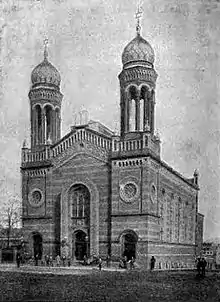Bytom Synagogue

Bytom Synagogue or Beuthen Synagogue was a synagogue in Beuthen, in the Prussian Province of Silesia (present-day Bytom, Poland), a border–town between Germany and the Second Polish Republic prior to German invasion of Poland in World War II. After the plebiscite of 1922, the border passed just east of Beuthen, so that neighboring Katowice was in Poland.
History
Beuthen Synagogue was built in 1869 on Friedrich-Wilhelm-Ring (now Plac Grunwaldzki), in place of an older one. The cornerstone was set on May 25, 1868, construction finished on July 2, 1869. Max Kopfstein (1856–1924) from Bad Ems became rabbi and religion teacher there in 1889. Chief Rabbi from 1919, he participated in the negotiations of the Treaty of Versailles as an expert in matters concerning the Jewish population in Upper Silesia.
The synagogue was burned down by Nazi German SS and SA troopers during the Kristallnacht on 9–10 November 1938. On November 7, 1938 Joseph Goebbels had delivered a fiery antisemitic tirade in Beuthen with a call for vengeance against Jews. They were made to stand for hours in front of their burning Moorish synagogue. Beuthen Jewish Community became the first ever Holocaust transport to be gassed inside "Bunker I" at Auschwitz-Birkenau death camp, all murdered on February 15, 1942, at the onset of the Nazi German Holocaust in Poland.[1][2][3]

A memorial plaque at the site was erected on November 9, 2007.
See also
References
- Jews deported from Beuthen (Bytom), list prepared in 1942 Archived 2009-07-15 at the Wayback Machine
- Elsa Drezner, Yizkor Book Project Manager Avraham Groll, Names of Jews deported from Beuthen Archived 2011-07-26 at the Wayback Machine
- Translations: deportation Archived 2011-07-26 at the Wayback Machine
External links
- Bytom Synagogue at Museum of the History of Polish Jews, Virtual Shtetl